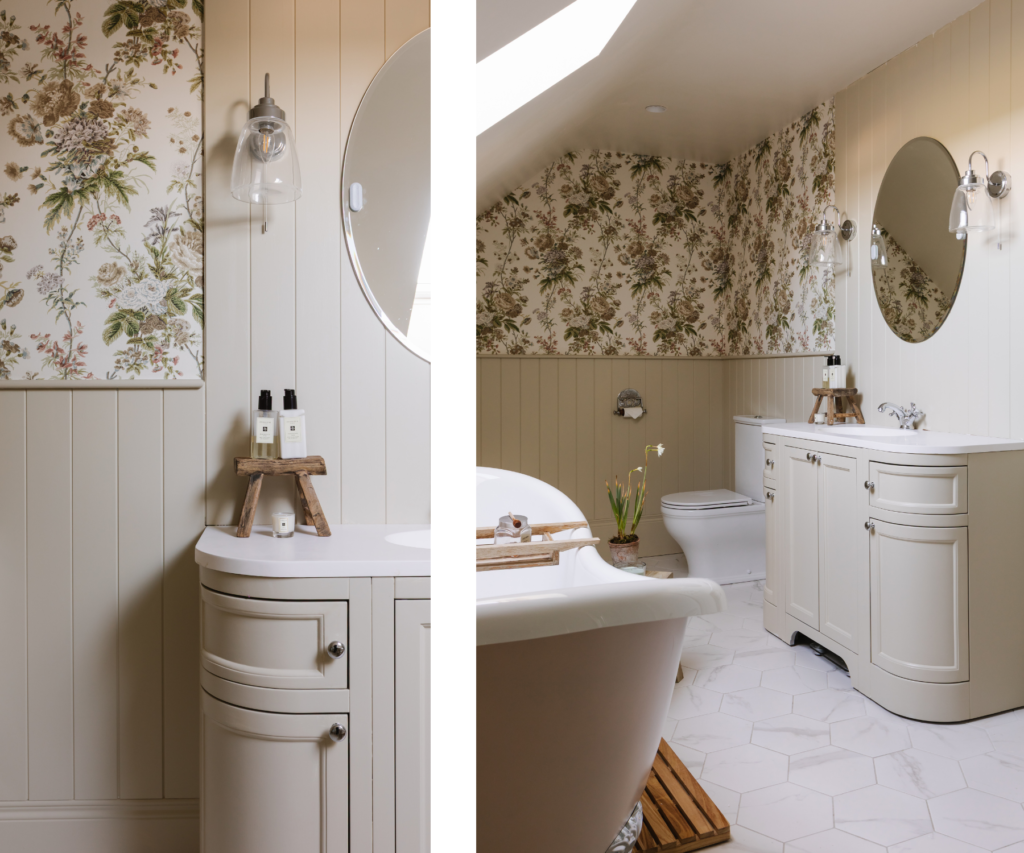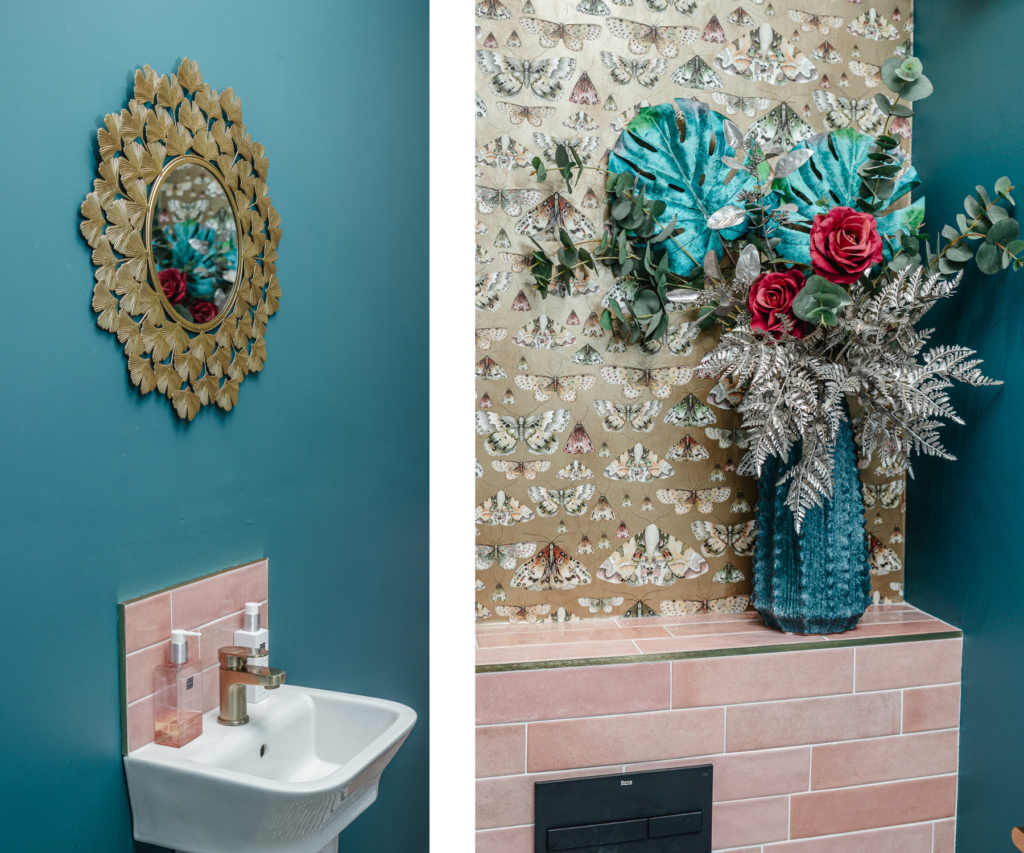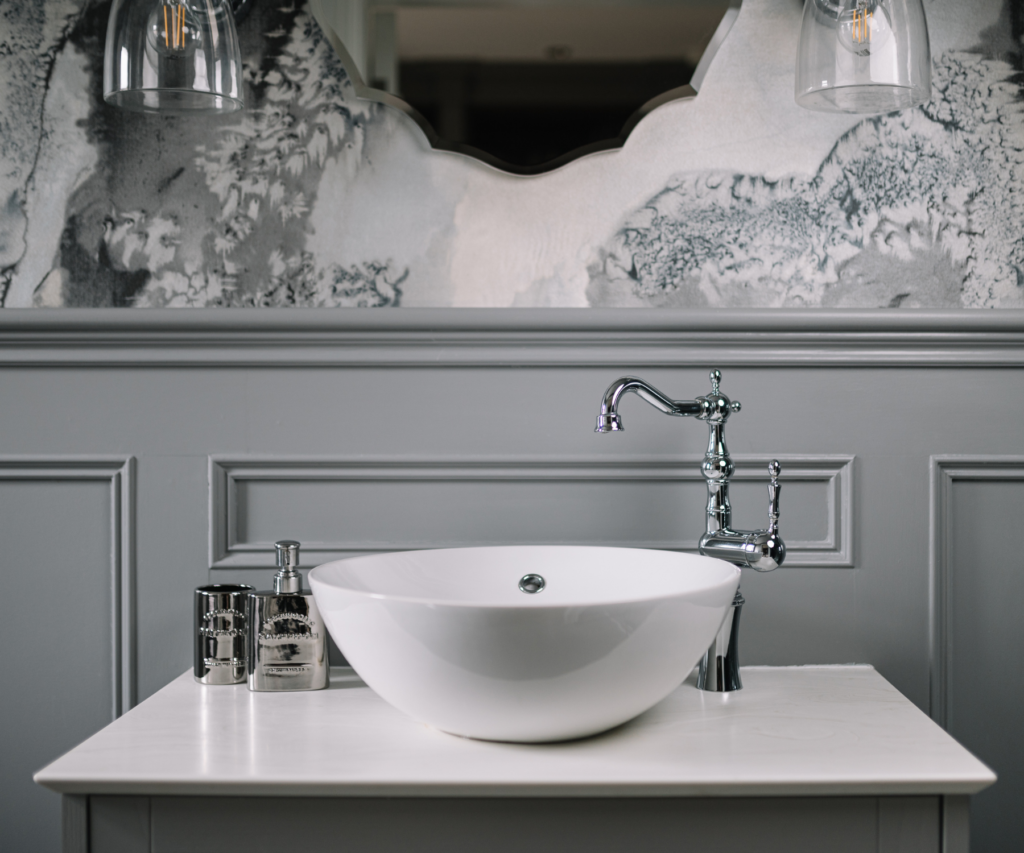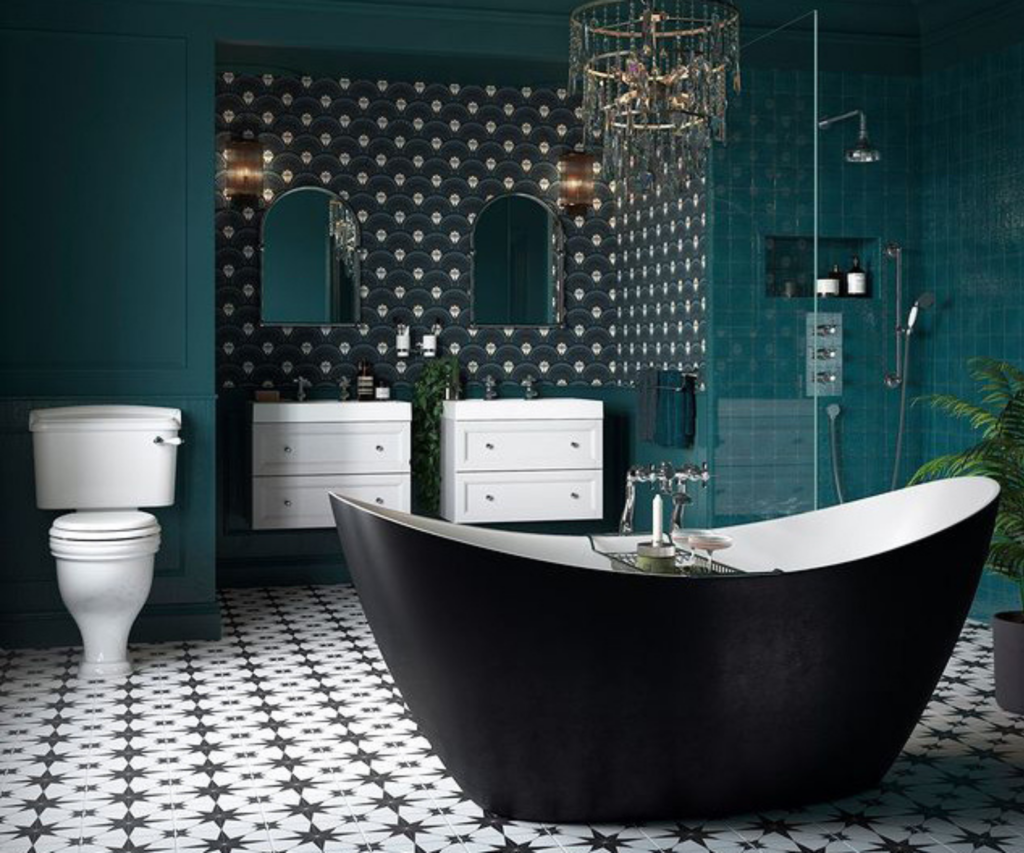Our Expert Tips for Wallpapering a Bathroom
So, if you’ve thought it through and still like the idea of wallpapering your bathroom – great choice. With the right prep and a few clever tricks, it can work really well. Here are our top tips to help you get the best result from start to finish.
1. Choose the right wallpaper
2. Prep the surface
3. Use a reliable adhesive
4. Try a wallpaper sealant
5. Stick to low-moisture areas
Tip 1. Choose the Right Bathroom Wallpaper
Bathrooms need wallpaper that can cope with steam, splashes, and humidity. The best option is vinyl or vinyl-coated wallpaper. It’s made to resist moisture and can be wiped down easily, which makes it much more practical than standard paper.
Can you use peel and stick wallpaper in a bathroom?
Yes, in some cases, peel and stick wallpaper can work in well-ventilated bathrooms that don’t get too steamy — like a guest toilet or cloakroom. Just avoid areas that get wet, and apply it to a clean, smooth surface.
Can you use normal wallpaper in a bathroom?
Regular wallpaper is not recommended for bathrooms. It can absorb moisture, which leads to peeling or mould. If you really want to use it, keep it away from sinks and showers, and think about using a wallpaper sealant to help protect it. Still, we’d usually recommend going with something more moisture-resistant.

Tip 2. Prepare the Surface Correctly
If you’re wallpapering the bathroom yourself, proper prep is a must. Bathrooms are tricky because of the moisture, and wallpaper won’t stick well to a damp or uneven surface.
Start by cleaning the wall with a mild sugar soap solution to remove any dust, grease, or leftover product. Rinse it down and let it dry fully. Any cracks or holes should be filled and sanded smooth. If the wall is already painted, give it a light sand to help the wallpaper grip.
We usually recommend using a professional decorator, especially in bathrooms. It’s easy to end up with bubbles or wrinkles if it’s not applied just right — and that can be even more of a problem in a humid space. But if you’re confident with DIY and take your time, it is doable.

Tip 3. Use a Reliable Wallpaper Adhesive
The type of adhesive you use matters just as much as the wallpaper itself, especially in a bathroom. You’ll need something strong enough to deal with humidity and keep the wallpaper in place over time.
For vinyl or bathroom-rated wallpaper, use a high-quality, heavy-duty adhesive. These are made to handle tougher conditions and help prevent the paper from peeling or slipping. Some wallpapers come with their own paste recommendations, so it’s worth checking the label before you start.
Even if you’ve hired a professional, it’s still good to make sure the right adhesive is being used. The wrong paste can cause problems later, and it’s harder to fix once everything’s up on the wall.

Tip 4. Try a Wallpaper Sealant
A wallpaper sealant is a clear protective coating that goes over your wallpaper to help protect it from moisture, steam, and stains. It’s not essential, but some people like the extra layer of protection in busy bathrooms or if they’ve used standard wallpaper.
Sealants come in different finishes, usually matte or satin. Look for one that’s water-based and breathable, so it doesn’t trap moisture behind the wallpaper. You can apply it with a soft brush or roller once the wallpaper is fully dry. One or two thin coats should be enough.
It won’t make your wallpaper waterproof, but it can help it last longer and make it easier to wipe down. If you’ve used a non-vinyl wallpaper or put it near a sink, a sealant can give you a bit more peace of mind.

Tip 5. Stick to Low-Moisture Areas
In bathrooms, wallpaper placement makes all the difference. Even the best wallpaper will struggle if it’s stuck right next to a shower head or over a bath that gets used daily.
High-moisture areas aren’t suitable for wallpaper, like inside shower enclosures, directly above baths, or behind sinks without a splashback. These spots get wet too often and the constant moisture will break down the adhesive or cause peeling over time.
Low-moisture areas are your safer zones. Think above half-height tiling, behind the toilet, or on a feature wall that doesn’t get direct water. In a cloakroom or guest toilet (where there’s less steam overall) you’ve got more freedom with where it goes.

Spruce Up Your Bathroom with Bassetts
Hopefully you’ve now got a clearer idea of how wallpaper can work in a bathroom. With the right prep and a bit of thought, it can really bring a touch of personality to your loo!
If you’re thinking about updating more than just the walls, we’d love to help. At Bassetts, we’ve been helping customers across Northern Ireland design bathrooms that work for them. Our free design service is a great way to get ideas and chat through your plans.
Call into your local showroom or book a free consultation now.
FAQs
Can you wallpaper a bathroom ceiling?
Yes, you can wallpaper a bathroom ceiling, but only if the room is well ventilated and doesn’t get too steamy. Use a lightweight vinyl wallpaper and a strong adhesive. Make sure the ceiling is smooth, clean, and completely dry before you start. It’s a great way to add a bit of interest without overwhelming the space.
Can you paint over wallpaper in a bathroom?
Yes, you can paint over wallpaper in a bathroom, but it’s only worth doing if the wallpaper is in good condition. Make sure it’s fully stuck down with no peeling edges or bubbles. Use an oil-based or mould-resistant primer first, then apply a paint that’s made for bathrooms. Keep in mind this is more of a short-term fix than a long-term solution.
Can you tile over wallpaper in a bathroom?
No, you shouldn’t tile directly over wallpaper. Tiles need a solid, clean surface to bond properly. Trying to tile over wallpaper can lead to movement, cracked grout, or tiles falling off. Strip the wallpaper completely, clean the surface, and make sure the wall is dry before tiling.
Can you put wallpaper in a bathroom with a shower?
Yes, you can wallpaper a bathroom that has a shower, but you’ll need to be smart about where you put it. Don’t use wallpaper inside the shower or anywhere that gets direct water. Instead, try it on a feature wall or above half-tiling, away from splashes. Always choose a moisture-resistant wallpaper and make sure your ventilation is good.
How do you clean wallpaper in a bathroom?
To clean wallpaper in a bathroom, gently wipe it down with a soft, damp cloth or sponge. Use warm water and a tiny bit of mild soap if needed. Avoid scrubbing or using anything too wet, especially near the edges. Only vinyl or washable wallpaper should be cleaned this way, paper wallpaper can easily get damaged.
What are some alternatives to wallpaper in a bathroom?
If wallpaper isn’t right for your space, there are plenty of other options. Paint is a simple choice, just make sure it’s made for bathrooms. Tiles are durable and waterproof, while PVC or acrylic wall panels are a good low-maintenance option. These are ideal for wet areas like showers and behind baths.






